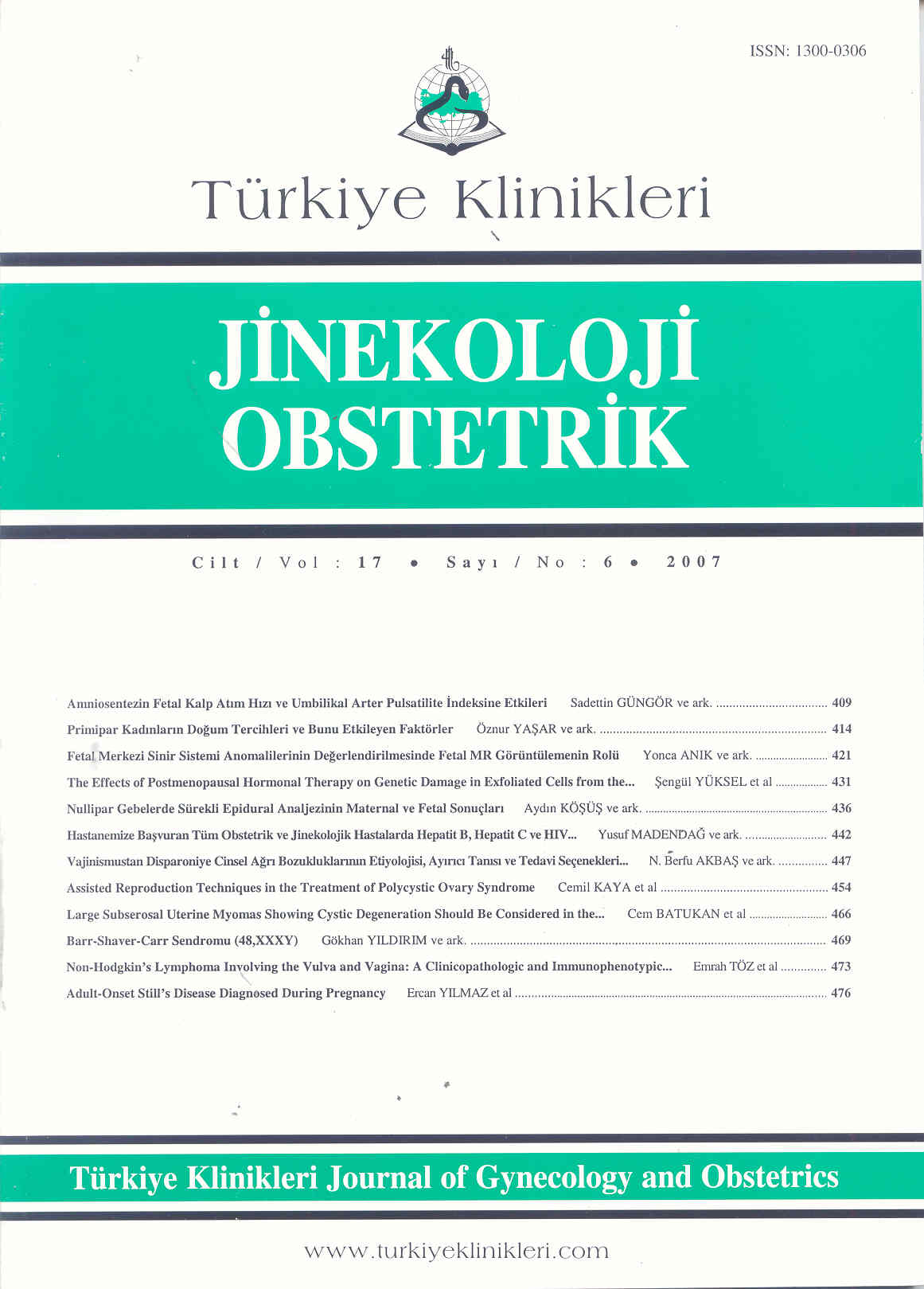Open Access
Peer Reviewed
ORIGINAL RESEARCH
3567 Viewed2582 Downloaded
The Role Of Fetal Mri In The Diagnosis Of Fetal Central Nervous System Anomalies
Fetal Merkezi Sinir Sistemi Anomalilerinin
Turkiye Klinikleri J Gynecol Obst. 2007;17(6):421-30
Article Language: TR
Copyright Ⓒ 2025 by Türkiye Klinikleri. This is an open access article under the CC BY-NC-ND license (http://creativecommons.org/licenses/by-nc-nd/4.0/)
ÖZET
Amaç: Bu çalışmanın amacı fetal merkezi sinir sistemi (MSS) anomalilerinde manyetik rezonans (MR) görüntülemenin rolünü araştırmaktır. Gereç ve Yöntemler: İntrauterin Ultrasonografi (US) incelemesinde MSS anomalisi saptanan veya şüphelenilen ve bunları takiben fetal MR inceleme yapılan 15 hastanın verileri retrospektif olarak değerlendirildi. Annelerin yaş dağılımı 20-36 yıllar arasıydı. Fetal yaş 16-33 gebelik haftası arasındaydı. Bulgular: Onbeş olgunun US ve MR bulguları karşılaştırıldığında; fetal MR bir olguda (korpus kallozum agenezisi) tanıyı kesinleştirirken (%6.6), beş olguda (primer aquadukt stenozuna sekonder triventriküler hidrosefali n=4 ve kompleks MSS anomalisi n= 1) anomalinin ayrıntılı tanımlanmasını sağlamıştır (%33.3), bir olguda ise ek patolojiyi (pineal glandda kitle) göstermiştir (%6.6). US'de hafif ventrikülomegali saptanan iki olgunun MR sonuçları normal bulunmuştur (%13.3). Sonuç: Fetal MR, fetal MSS anomalilerinin değerlendirilmesinde son derece önemli bir modalite olup, US incelemesinde MSS anomalisi saptanan veya kuşkulanılan olgularda anomalinin ayrıntılı tanımlanmasında ve ek anomali saptanmasında belirgin rol oynar.
Amaç: Bu çalışmanın amacı fetal merkezi sinir sistemi (MSS) anomalilerinde manyetik rezonans (MR) görüntülemenin rolünü araştırmaktır. Gereç ve Yöntemler: İntrauterin Ultrasonografi (US) incelemesinde MSS anomalisi saptanan veya şüphelenilen ve bunları takiben fetal MR inceleme yapılan 15 hastanın verileri retrospektif olarak değerlendirildi. Annelerin yaş dağılımı 20-36 yıllar arasıydı. Fetal yaş 16-33 gebelik haftası arasındaydı. Bulgular: Onbeş olgunun US ve MR bulguları karşılaştırıldığında; fetal MR bir olguda (korpus kallozum agenezisi) tanıyı kesinleştirirken (%6.6), beş olguda (primer aquadukt stenozuna sekonder triventriküler hidrosefali n=4 ve kompleks MSS anomalisi n= 1) anomalinin ayrıntılı tanımlanmasını sağlamıştır (%33.3), bir olguda ise ek patolojiyi (pineal glandda kitle) göstermiştir (%6.6). US'de hafif ventrikülomegali saptanan iki olgunun MR sonuçları normal bulunmuştur (%13.3). Sonuç: Fetal MR, fetal MSS anomalilerinin değerlendirilmesinde son derece önemli bir modalite olup, US incelemesinde MSS anomalisi saptanan veya kuşkulanılan olgularda anomalinin ayrıntılı tanımlanmasında ve ek anomali saptanmasında belirgin rol oynar.
ANAHTAR KELİMELER: Fetal, manyetik rezonans görüntüleme, prenatal ultrasonografi, merkezi sinir sistemi
ABSTRACT
Objective: The aims of this study to investigate the role of magnetic resonance imaging (MRI) in the diagnosis of fetal central nervous system (CNS) anomalies. Material and Methods: Fetal MRI findings of 15 fetuses of 15 pregnant women, who have or suspected to have CNS anomalies on intrauterine ultrasonography (US) were evaluated retrospectively. The age range of the women were 20-36 years, fetal ages were between 16-33 gestational weeks. Results: Comparison of US and MR findings revealed that fetal MRI assured the diagnosis (callosal agenesis) in one case (6.6%), defined the anomalies (hydrocephalus due to primary aquaductal stenosis n= 4 and complex CNS anomaly) in details in five cases (33.3%) and defined additional pathology (pineal gland mass lesion) in one case (6.6%). MRI findings were found in normal limits of two patients (13.3%) that referred with mild ventriculomegaly. Conclusion: Fetal MRI is a very important modality in the evaluation of fetal CNS anomalies, plays an important role on defining the anomaly in details and on detecting additional anomalies in cases with or suspected CNS anomalies on US examination.
Objective: The aims of this study to investigate the role of magnetic resonance imaging (MRI) in the diagnosis of fetal central nervous system (CNS) anomalies. Material and Methods: Fetal MRI findings of 15 fetuses of 15 pregnant women, who have or suspected to have CNS anomalies on intrauterine ultrasonography (US) were evaluated retrospectively. The age range of the women were 20-36 years, fetal ages were between 16-33 gestational weeks. Results: Comparison of US and MR findings revealed that fetal MRI assured the diagnosis (callosal agenesis) in one case (6.6%), defined the anomalies (hydrocephalus due to primary aquaductal stenosis n= 4 and complex CNS anomaly) in details in five cases (33.3%) and defined additional pathology (pineal gland mass lesion) in one case (6.6%). MRI findings were found in normal limits of two patients (13.3%) that referred with mild ventriculomegaly. Conclusion: Fetal MRI is a very important modality in the evaluation of fetal CNS anomalies, plays an important role on defining the anomaly in details and on detecting additional anomalies in cases with or suspected CNS anomalies on US examination.
MENU
POPULAR ARTICLES
MOST DOWNLOADED ARTICLES





This journal is licensed under a Creative Commons Attribution-NonCommercial-NoDerivatives 4.0 International License.










